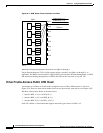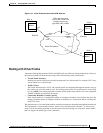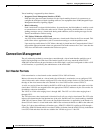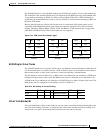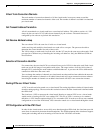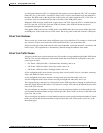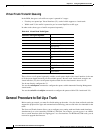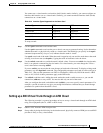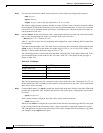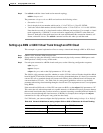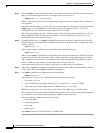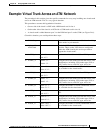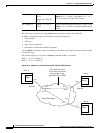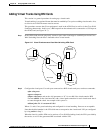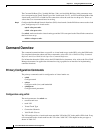
24-14
Cisco BPX 8600 Series Installation and Configuration
Release 9.3.10, Part Number 78-11603-01 Rev. D0, July 2001
Chapter 24 Configuring BXM Virtual Trunks
General Procedure to Set Up a Trunk
Step 3 For each port connected to a BNI virtual trunk port, use the following configuration sequence:
upln slot.port
upport slot.port
cnfport slot.port, and set the shift parameter to “N” for no shift.
The Shift/No shift parameter specifies whether or not the VCI bits in the cell header should be shifted
based on the HCF field of the cell header on cells arriving from the backplane. It is how Cisco networks
convert STI cells to standards based cell formats, and similarly how standards-based cell formats are
convertedbacktoSTIcells.
Step 4 Execute addcon. In the cloud network, add a virtual path connection for each end of the virtual trunk
that is to be routed through the cloud. An example of the syntax for this is:
addcon joker 5.1.1.* swstorm 6.2.10.*
where 5.1 and 6.2 are ports that are hooked up and configured for virtual trunking. DACS connections
are acceptable.
Note that the third number is the VPI, which must correspond to the virtual trunk VPI configured with
cnftrk in step 4. For BNI virtual trunks, the usable range of VPIs is 1 to 255 (for T3/E3 trunks). For
BNI OC-3 virtual trunks, the usable range of VPIs is 1–63.
The VPI configured for a virtual trunk must match the VPI of the VPC in the public ATM cloud. Every
cell transmitted to the virtual trunk has this VPI value. Valid VPC VPIs depend on the port type as
showninTable24-5.
The Cbr/Vbr parameter must also correspond to the virtual trunk type of the virtual trunk. For T3, set
PCR to 96000 and CDTV to 24000 for the connection so that the does not drop cells. Cisco recommends
these values based on testing.
Step 5 Configure BNI trunks. Use uptrk to enable the virtual trunk on the port. Take this step if the ATM cloud
provider has assigned the VPC. On BNIs that connect to the cloud’s ports, configure the virtual trunks,
as follows:
uptrk slot.port.vtrk
If the cloud is already configured, the alarm on the virtual trunk should clear.
cnftrk slot.port.vtrk
When you use cnftrk to configure the virtual trunk, make sure the virtual trunk type and VPI correspond
to the existing Virtual Path connections (that is, make sure that the virtual trunk matches the cloud’s
VPC configuration, uses the correct cell format (UNI or NNI), and that HCF-based shifting is off (which
you configure using cnfport on the port).
Table 24-5 VPI Ranges
Port Type Valid VPI Range
BXM/UXM (UNI) 1-255
BXM/UXM (NNI) 1-4095
BNI T3/E3 1-255
BNI OC-3 1-63



